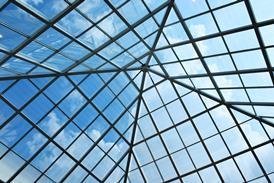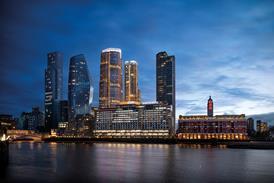"We wanted to use our own materials and to put our own low-energy philosophy into the building," says Arne Damsgaard Olsen, Rockwool's project leader.
Set in the gently sloping grounds of the company's Danish headquarters at Hedehusene near Copenhagen, the now complete ����Ӱ�� 2000 looks functional and modern. A two-storey structure comprises two wings of offices running north-south, linked by a third at right angles, forming an H-shaped plan. Inside, the 4200 m² complex is home to 130 engineers, researchers and laboratory staff.
The building was designed by Jens Arnfred of Danish architect Drawing Office. Unsurprisingly, given the nature of Rockwool's business, the emphasis is on saving energy through the use of insulation.
However, it is not just energy in use that the architect had to address. Impact on the environment both now and in the future was to be kept to a minimum. And finally, the design was to help change the company's insular working environment, encouraging spontaneous interaction between the departments it housed.
Setting insulation levels, Rockwool looked 50 years into the future. "We decided to build to Danish ����Ӱ�� Regulations for 2050," explains Damsgaard Olsen. Using information from the Danish and German ����Ӱ�� Institutes, the team set U-values far in excess of the current Danish regulations. The resulting estimated heating load of 15 kWh/m²/year is 72% less than the already-rigorous Danish energy requirements.
To achieve such a low heat load, the building has been cocooned in a variety of Rockwool products. "We gave the architect a few grey hairs trying to get him to fit all our products into the one building," Damsgaard Olsen admits.
A quick tour confirms that if Arnfred has not managed to incorporate all the company's products, he has certainly given it his best shot. A 300 mm thick blanket of Rockwool insulation board cloaks the roof, laid on top of Rockwool's plywood-faced System Roof panels. The walls are protected by a layer of insulation 450 mm thick, the ground floor is constructed on a 250 mm thick mat, and some elevations have been clad in Black Rockpanel. The building's steel frame is fire-protected using Rockwall Conlit, and the offices are soundproofed with Rockfon acoustic ceilings. Even the plants are potted in the company's Grodan stone wool.
The architect has mischievously chosen to clad some of the external facades in glass so that the company's insulation products are on show.
With so much insulation stuffed into the building's envelope, the design team was hoping that the building would operate without a heating system. However, calculations by the consulting engineer Erik K Jorgensen showed that in winter, particularly on a Monday morning, a quick blast of heat would be required to raise temperatures to a comfortable level.
"We decided to opt for an electric heating system," says Damsgaard Olsen. However, the mayor of the commune had other ideas: "He said we were not allowed to use electricity for heating." After running a life-cycle analysis for both electric and gas-fired hot water heating systems, the team was forced to agree with the mayor and opt for gas. Life-cycle analysis was also used to select the construction materials and to assess performance throughout the lifespan of the project. In all, 7445 tonnes of building material were used. "It works out at 23p/kg, and that's cheaper than the price of potatoes," Damsgaard Olsen jokes.
Achieving the right internal environment for the building's occupants while minimising energy consumption was another challenge. "It is easy to create a low-energy house – you just throw a lot of insulation at it," says Damsgaard Olsen. "But it is difficult to get a pleasant internal environment with enough daylight and fresh air." Air-conditioning was not an option. "In Denmark, you have to get permission from the government," says Damsgaard Olsen.
Instead, a natural ventilation strategy was devised for the full height triple-glazed windows along the building's east, west and southern elevations, specially manufactured by Velux to minimise heat loss.
Computer-controlled, motorised toplights allow air to enter the building and pass through the offices, before leaving through a row of openable rooflights.
To guard against draughts, the team used software developed to model airflow around aircraft, to decide which windows to open. "We were able to predict where the wind would exert pressure and where it would develop areas of suction around the building, and to program the window-opening software accordingly," explains Damsgaard Olsen. The same software switches off the heating in areas where windows are open.
There is a synergy between the desire for natural ventilation of the offices and cross-departmental communication. The lack of internal walls helps air and staff move effectively throughout the building, creating the flexibility necessary for a more fluid team structure. "We hope the output from teams working in this building will be faster," says Damsgaard Olsen.
The building cost a little under £4m to construct, or about £1100/m², an increase of around £300/m2 on a typical Danish office. "The extra cost is not excessive," says Damsgaard Olsen. "Some 35% of the increase is the cost of the additional insulation, but the majority is due to the cost of the ultra-low-energy windows." Both the Danish ����Ӱ�� Research Institute and the Danish Technical University are monitoring the building's performance. "Now we've finished construction, we have to prove it meets our target of 15 kWh/m²/year," says Damsgaard Olsen.























